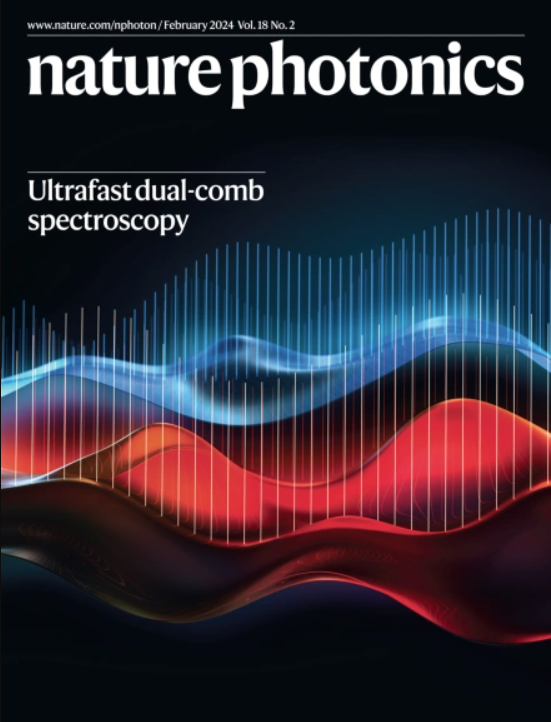超高亮度近红外有机发光二极管
IF 32.9
1区 物理与天体物理
Q1 OPTICS
引用次数: 0
摘要
近红外有机发光二极管具有广泛的应用吸引力,包括夜间监测和生物医学诊断和成像系统。然而,由于在高电流密度下的快速效率滚降,获得高器件辐射度(这是许多应用所必需的)并保持高运行稳定性具有挑战性。在这里,我们开发了基于受体-供体-受体有机半导体的近红外有机发光二极管,极大地抑制了单线态-三重态湮灭速率和三重态寿命,减轻了长寿命三重态的单线态猝灭,从而在高电激发水平下实现了超高的单线态密度。器件的J50值为59.2 A cm−2,即外部量子效率下降到其峰值1.34%的一半的电流密度。在电流密度的6个数量级范围内(大于5000 A cm−2),也能保持高的外量子效率。该器件在连续电偏压下的最大辐射强度超过2,000 W sr−1 m−2,在脉冲电操作下的最大辐射强度超过46,700 W sr−1 m−2。当初始辐照度为100wsr−1 m−2时,半衰期为35h。我们还实现了1,000 a cm - 2下超过1016 cm - 3的高电注入单重态密度,可以维持种群反转,表明有机激光器的潜力。这些结果为近红外有机发光二极管的进一步发展铺平了道路,也为电驱动有机激光二极管的发展提供了一条潜在的途径。本文章由计算机程序翻译,如有差异,请以英文原文为准。


Ultrahigh-radiance near-infrared organic light-emitting diodes
Near-infrared organic light-emitting diodes are attractive for a broad range of applications, including night-time surveillance and biomedical diagnostic and imaging systems. However, obtaining high device radiance, which is necessary for many applications, and maintaining high operational stability is challenging due to the rapid efficiency roll-off at a high current density. Here we develop near-infrared organic light-emitting diodes based on an acceptor–donor–acceptor organic semiconductor with greatly suppressed singlet–triplet annihilation rate and triplet lifetime, alleviating singlet quenching by long-lived triplets, thereby enabling an ultrahigh singlet density at high electrical excitation levels. Our devices exhibit J50 values of 59.2 A cm−2, that is, the current density at which the external quantum efficiency decreases to half its peak value of 1.34%. A high external quantum efficiency is also maintained over a six orders of magnitude range of current densities, at values above 5,000 A cm−2. The devices emit with the maximum radiance beyond 2,000 W sr−1 m−2 under a continuous electrical bias and 46,700 W sr−1 m−2 in the pulsed electrical operation. The half-lifetime is 35 h for an initial radiance of 100 W sr−1 m−2. We also achieve a high electrically injected singlet density of more than 1016 cm−3 at 1,000 A cm−2, which can sustain population inversion, indicating potential for organic lasers. These results pave the way for further developments of near-infrared organic light-emitting diodes as well as offer a potential route towards electrically driven organic laser diodes. An acceptor–donor–acceptor organic semiconductor enables near-infrared organic light-emitting diodes with reduced efficiency roll-off over six orders of magnitude of excitation current density, enabling a maximum luminance of 2,000 W sr−1 m−2.
求助全文
通过发布文献求助,成功后即可免费获取论文全文。
去求助
来源期刊

Nature Photonics
物理-光学
CiteScore
54.20
自引率
1.70%
发文量
158
审稿时长
12 months
期刊介绍:
Nature Photonics is a monthly journal dedicated to the scientific study and application of light, known as Photonics. It publishes top-quality, peer-reviewed research across all areas of light generation, manipulation, and detection.
The journal encompasses research into the fundamental properties of light and its interactions with matter, as well as the latest developments in optoelectronic devices and emerging photonics applications. Topics covered include lasers, LEDs, imaging, detectors, optoelectronic devices, quantum optics, biophotonics, optical data storage, spectroscopy, fiber optics, solar energy, displays, terahertz technology, nonlinear optics, plasmonics, nanophotonics, and X-rays.
In addition to research papers and review articles summarizing scientific findings in optoelectronics, Nature Photonics also features News and Views pieces and research highlights. It uniquely includes articles on the business aspects of the industry, such as technology commercialization and market analysis, offering a comprehensive perspective on the field.
 求助内容:
求助内容: 应助结果提醒方式:
应助结果提醒方式:


